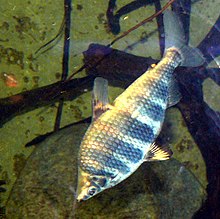Anostomidae
| Anostomidae | |
|---|---|

| |
| Abramites hypselonotus in headstander swimming pose | |
| Scientific classification | |
| Domain: | Eukaryota |
| Kingdom: | Animalia |
| Phylum: | Chordata |
| Class: | Actinopterygii |
| Order: | Characiformes |
| Suborder: | Characoidei
|
| Family: | Anostomidae Günther, 1864[1] |
| Genera | |
|
Presently 14, but see text | |
| Synonyms | |
|
Anostomina Günther, 1864 | |
The Anostomidae are a
Description
Anostomids have elongated bodies ranging from 15 to 60 cm (5.9 to 23.6 in) in length; their shape varies between
Their jaws are rather short, with the maxillary bone small and excluded from the mouth opening, while the ascending process of the premaxilla is triangular in overall shape and robustly developed. One row of six or eight curved teeth occur in each jaw, arranged by length in a step-like fashion, with the front teeth being the longest; the pharyngeal teeth are enlarged and have two or more cusps each.[3]
Anostomid
The
Systematics and evolution

This family is in all probability
But the latter view is incorrect, as it includes a large number of lineages that are really
Evolution and fossil record
The
The origin of the Anostomidae can be quite confidently placed in the
Genera
The genera of Anostomidae are:[1]
Basal lineages
- Abramites (two species)
- Anostomoides (three species)
- Hypomasticus (seven species)
- Leporellus (four species)
- paraphyletic)
- Megaleporinus (10 species)[7]
Schizodon clade
Anostominae sensu stricto
- Anostomus (five species)
- Gnathodolus (one species)
- Laemolyta (9 species)
- Petulanos (three species)
- Pseudanos (four species; paraphyletic?)
- Sartor (three species)
- Synaptolaemus (two species)
In Brazil, many species of Leporinus, Rhytiodus, and Schizodon are called aracu.[8]
References
- ^ a b c d e f Sidlauskas & Vari (2008)
- ^ a b c FishBase (2004), Sidlauskas & Vari (2008)
- ^ a b Weitzman & Vari (1998), FishBase (2004), Sidlauskas & Vari (2008)
- ^ "La Venta formation" in Sidlauskas & Vari (2008) is the old name.
- .
- ^ Filleul & Maisey (2004), Sidlauskas & Vari (2008)
- ^ Ramirez, J.L., Birindelli, J.L.O. & Galetti, P.M.Jr. (2017): A new genus of Anostomidae (Ostariophysi: Characiformes): Diversity, phylogeny and biogeography based on cytogenetic, molecular and morphological data. Molecular Phylogenetics and Evolution, 107: 308–323.
- ^ Aracus. www.amazonwaters.org.
Further reading
- Filleul, Arnaud & Maisey, John G. (2004): Redescription of Santanichthys diasii (Otophysi, Characiformes) from the Albian of the Santana Formation and comments on its implications for otophysan relationships. American Museum Novitates 3455: 1-21. PDF fulltext
- FishBase (2004): Family Anostomidae - Headstanders. Version of 2004-NOV-22. Retrieved 2009-FEB-26.
- Sidlauskas, Brian L. & Vari, Richard P. (2008): Phylogenetic relationships within the South American fish family Anostomidae (Teleostei, Ostariophysi, Characiformes). (HTML abstract)
- Weitzman, S.H. & Vari, Richard P. (1998): [Anostomidae]. In: Paxton, J.R. & Eschmeyer, W.N. (eds.): Encyclopedia of Fishes: 104. Academic Press, San Diego. ISBN 0-12-547665-5
